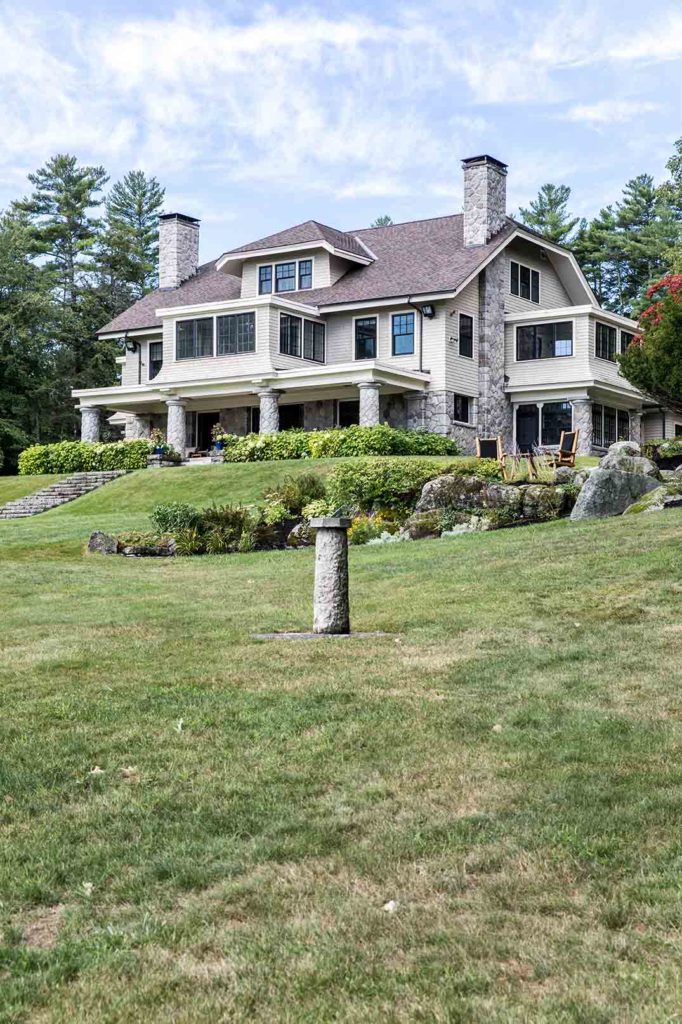A Century of Summers
Restoring an old Sebago Lake hunting lodge to its former glory

One hundred years ago, Dorothy Spaulding sat down on the porch of her new summer house for the very first time. She looked out at Sebago Lake. She saw a green lawn, white birch, blue water. She saw her stone pillars, which had been custom-built by Italian masons to her exacting standards. (She knew many of the stones by sight; she had decided where each one would go. She knew which ones came from the quarries in Norway, Maine, and which from the one in Paris.) She saw her sundial. She must have watched as the shadows crawled over the face of it, marking the passage of time.

Spaulding probably didn’t know when she and her husband Leon built Rockcraft that the hunting lodge on the edge of Sebago would be her final resting place. Maybe she always dreamed of being buried there. Spaulding was young when she and Leon built the grand mansion. He died soon after, and she lived as a widow for decades, spending winters at the Park Hotel in New York and summers at Rockcraft. But she wasn’t entirely alone—her maids came with her, carrying her furs and jewels from place to place, until finally Spaulding decided to retire to Maine. Her husband is buried here, in a stone mausoleum. When Spaulding died, she was buried with him. The mausoleum was walled off, though descendants of the Spauldings can still access it anytime they please. She put provisions for that in her last will.
I heard the story of lonely Spaulding and her maids from Karen Russell, the current owner of Rockcraft Lodge. Russell heard it from one of the maids herself, who came by to visit after Russell and her brother, David, had finished restoring the property. “She was in her 80s, but she still had wonderful memories of Dorothy,” Russell says. “She talked about how independent she was, how generous she was, how much she loved it here.”
Russell, too, loves it. It’s clear from talking with her that Rockcraft has become a part of her internal landscape. Like Spaulding, she knows the property inside and out. For the past nine years, Russell has been striving to learn everything about the house and the land. When she and David purchased the house in 2011, it was rundown, decrepit. It had been used for church retreats for over 40 years, and the constant stream of visitors had tired out the majestic old shingle-style mansion. “The kitchen was ghastly, it really was,” says Russell. But being able to restore Rockcraft to its former glory? That was thrilling. “Of course, it was daunting, too,” she adds.

In some of the rooms, the Russell siblings opted to paint the wood paneling a lighter shade, but they kept the library dark and moody. “There’s even a secret room off the library,” Karen reveals. “It’s where they used to store all the illegal liquor” 
“I have sketches Dorothy made of the fireplaces where she identified each stone and where it came from,” Karen Russell says with reverence for the original owner and her detail-oriented nature. “They supposedly brought in 30 master stone masons from Italy to do all the stone work, inside and out.”
“We wanted to recreate the original layout as much as possible,” says Russell. “When we were renovating, my brother did a tremendous amount of research. He wanted everything to be as authentic as we could make it.” To that end, they left the dark wood paneling in the library. They left the fireplaces and the pinewood floors. They painted the wood paneling in the great room to lighten it up a bit, and they recreated the original layout up-stairs. Many of the original light fixtures had been lost, but the Russells were able to source antiques from the period, hanging chandeliers and installing brass sconces throughout the house. They found claw-foot tubs for the bathrooms and wicker chairs for the porch. Although they brought in some contemporary furnishings, the Russells tried to keep the spirit of Rockcraft intact. They didn’t want to live in a museum, but they did want to treat Dorothy and Leon’s home with respect.
Now, Rockcraft is a vacation cottage once again. The Russells make the drive up from Boston frequently, even in the dead of winter. They also rent it out for events and weddings. And when they first completed the renovation, they hosted an open house so that their neighbors could come by and take a look. “It was mobbed,” Russell says. “So many people came who had a personal connection to Rockcraft. People were worried that someone was going to buy the land and knock it down and develop it. We didn’t. We brought it back.”

